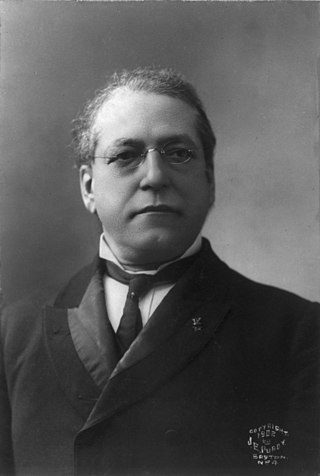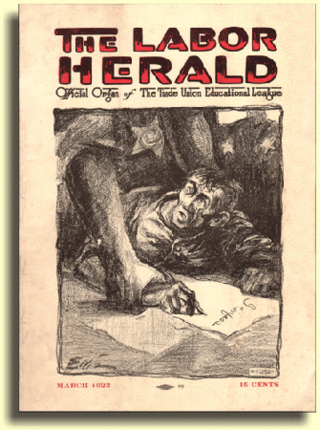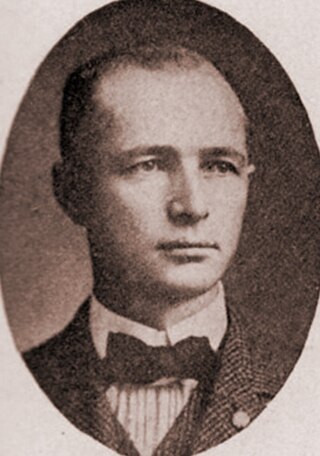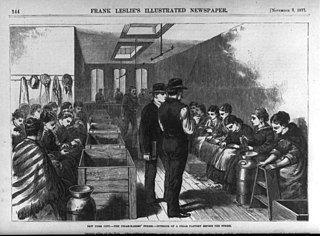
The United Hatters of North America (UHU) was a labor union representing hat makers, headquartered in the United States.

The United Hatters of North America (UHU) was a labor union representing hat makers, headquartered in the United States.
The UHU was founded and received a charter in the American Federation of Labor in 1896 through a merger of the International Trade Association of Hat Finishers of America and the National Hat Makers' Association of the United States. [1] One of its co-founders was John A. Moffitt, who served consecutively as UHU vice president, president, and editor of its official journal from 1896 to 1911. [2]

In 1934, the UHU merged with the Cloth Hat, Cap and Millinery Workers International Union to form the United Hatters, Cap and Millinery Workers International Union (UHCMW), a founding member of the Committee for Industrial Organizations. Subsequent mergers led to the formation of the Amalgamated Clothing and Textile Workers Union (ACTWU) in 1983, and the Union of Needletrades, Industrial and Textile Employees (UNITE) in 1995. [3]
The UHU was the de facto defendant in the landmark 1908 United States Supreme Court Loewe v. Lawlor decision, which was found adversely for the UHU and, by extension, for all unions in the United States. Loewe v. Lawlor outlawed secondary boycotts and ruled that individual union members could be held personally liable for damages incurred by their union. [4]

Samuel Gompers was a British-born American cigar maker, labor union leader and a key figure in American labor history. Gompers founded the American Federation of Labor (AFL) and served as the organization's president from 1886 to 1894, and from 1895 until his death in 1924. He promoted harmony among the different craft unions that comprised the AFL, trying to minimize jurisdictional battles. He promoted thorough organization and collective bargaining in order to secure shorter hours and higher wages, which he considered the essential first steps to emancipating labor.

The American Federation of Labor was a national federation of labor unions in the United States that continues today as the AFL–CIO. It was founded in Columbus, Ohio, in 1886 by an alliance of craft unions eager to provide mutual support and disappointed in the Knights of Labor. Samuel Gompers was elected the full-time president at its founding convention and was re-elected every year except one until his death in 1924. He became the major spokesperson for the union movement.

The nature and power of organized labor in the United States is the outcome of historical tensions among counter-acting forces involving workplace rights, wages, working hours, political expression, labor laws, and other working conditions. Organized unions and their umbrella labor federations such as the AFL–CIO and citywide federations have competed, evolved, merged, and split against a backdrop of changing values and priorities, and periodic federal government intervention.
Craft unionism refers to a model of trade unionism in which workers are organised based on the particular craft or trade in which they work. It contrasts with industrial unionism, in which all workers in the same industry are organized into the same union, regardless of differences in skill.

The Federation of Organized Trades and Labor Unions of the United States and Canada (FOTLU) was a federation of labor unions created on November 15, 1881, at Turner Hall in Pittsburgh. It changed its name to the American Federation of Labor (AFL) on December 8, 1886.
The Amalgamated Clothing and Textile Workers Union (ACTWU) was a labor union representing workers in two related industries in the United States.

The Trade Union Educational League (TUEL) was established by William Z. Foster in 1920 as a means of uniting radicals within various trade unions for a common plan of action. The group was subsidized by the Communist International via the Workers (Communist) Party of America from 1922. The organization did not collect membership dues but instead ostensibly sought to both fund itself and to spread its ideas through the sale of pamphlets and circulation of a monthly magazine.
The Journeymen Cigar Makers' International Union of America (CMIU) was a labor union established in 1864 that represented workers in the cigar industry. The CMIU was part of the American Federation of Labor from 1887 until its merger in 1974.
The International Typographical Union (ITU) was a US trade union for the printing trade for newspapers and other media. It was founded on May 3, 1852, in the United States as the National Typographical Union, and changed its name to the International Typographical Union at its Albany, New York, convention in 1869 after it began organizing members in Canada. The ITU was one of the first unions to admit female members, admitting women members such as Augusta Lewis, Mary Moore and Eva Howard in 1869.
Loewe v. Lawlor, 208 U.S. 274 (1908), also referred to as the Danbury Hatters' Case, is a United States Supreme Court case in United States labor law concerning the application of antitrust laws to labor unions. The Court's decision effectively outlawed the secondary boycott as a violation of the Sherman Antitrust Act, despite union arguments that their actions affected only intrastate commerce. It was also decided that individual unionists could be held personally liable for damages incurred by the activities of their union.

Maximillian Sebastian Hayes was an American newspaper editor, trade union activist, and socialist politician. In 1912 Hayes became the first candidate to challenge Samuel Gompers for the presidency of the American Federation of Labor in nearly a decade, drawing about 30 percent of the vote in his losing effort. Hayes is best remembered as the long-time editor of the Cleveland Citizen and as the vice presidential candidate of the Farmer–Labor Party ticket in 1920.
Alex Rose was a labor leader in the United Hatters of North America (UHNA) and the United Hatters, Cap and Millinery Workers International Union (UHCMW), a co-founder of the American Labor Party, and vice-chairman of the Liberal Party of New York.
The United Hatters, Cap and Millinery Workers International Union (1934–1983), also known by acronyms including UHCMW, U.H.C. & M.W.I.U. and UHC & MWIU, was a 20th-century American labor union.

The cigar makers' strike of New York lasted from mid-October 1877 until mid-February 1878. Ten thousand workers walked out at the height of the strike, demanding better wages, shorter hours and better working conditions, especially in the tenement manufacturing locations. The strike was supported by the Cigar Makers International Union of America, local chapter 144.
Max Zaritsky (1885–1959) was an American union leader of the United Hatters, Cap and Millinery Workers International Union (UHCMW) as well as co-founder of both the American Labor Party and Liberal Party of New York State.
The Cloth Hat, Cap and Millinery Workers International Union (CHCMW) was a trade union representing workers involved in making headwear in the United States and Canada.
John A. Moffit was an American labor unionist and government official.
Michael F. Greene was an Irish-born American labor union leader.
Martin Lawlor was an Irish-born American labor union leader.